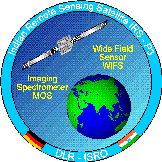HEASoft and XSPEC are now available as conda packages. See details ....
IRS-P3

 Mission Overview
Mission Overview
The Indian Remote Sensing Satellite IRS-P3 was launched with the third test launch of the Indian Polar Satellite Launch Vehicle PSLV at March 21st 1996. It is an experimental mission mainly oriented on earth remote sensing. The launcher and the satellite bus was provided by the Indian Space Research Organization ISRO, a part of the payload has been provided by German Aerospace Research Establishment DLR in the frames of the Indian-German Agreement on scientific and technological cooperation.
The payload consists of three instruments:
- the Wide Field Scanner WiFS, provided by ISRO
- the Modular Optoelectronic Scanner MOS, provided by DLR
- an X-Ray astronomy experiment by ISRO.
| Orbit: | polar, sun-synchronous circular |
|---|---|
| Altitude: | 817 km |
| Inclination: | 98.69 deg |
| Eccentricity: | 0.0004 |
| Period: | 101.35 minutes |
 Instrumentation
Instrumentation
The Indian X-ray Astronomy Instrument aboard the satellite consists of two instruments. The Pointed-mode Proportional Counters (PPC) consists of three identical, coaligned, multilayer proportional counters collimated to a 2 deg x 2 deg field-of-view, with each with an effective area of 400 sq-cm. The proportional counters are sensitive to 2 - 18 keV photons. The X-ray Sky Monitor (XSM) is a a pinhole camera with 1 sq-cm opening placed above a position sensitive proportional counter. The instrument has a 90 deg x 90 deg field-of-view and is sensitive to 3 - 8 keV photons. The viewing axes of the PPCs is aligned with the roll axis of the satellite while the XSM is offset by 35 degrees in the roll-pitch plane.
The principle objective of the X-ray Astronomy Instrument is to carry out timing studies of X-ray pulsars, X-ray binaries, and other rapidly varying X-ray sources. The XSM detects transient X-ray sources and monitors the light intensity of bright X-ray binaries.
The in-orbit performance checks of the X-ray Instrument was carried out May 1 - May 9 1996 by pointing the PPCs towards Cyg X-1. All instruments have been checked out. Due to the polar orbit of IRS-P3, most orbits pass through the South Atlantic Anamoly and regions of high intensity charged particles while the satellite's latitude is more than 50 degrees from the equator (North or South). To protect the instrumentation, the high voltage levels are reduced during SAA passages and when the latitude is +/- 50 or higher/lower. This reduces the useful duty cycle to roughly 15% of the satellite's orbit. The summed background of the 3 PPCs in the 2 - 18 keV range is about 45 counts per second when no X-ray point source is in the field-of-view.
Since the primary objective of the satellite was to carry out remote sensing, the time for stellar mode observation was limited to 2 months in a year. The stellar mode observations were made using a star tracker and gas jets for moving the satellite from earth pointing to stellar pointing mode and for correction due to drift of gyros. The satellite and the x-ray instrument is still healthy and working. However the x-ray observations came to an end on June 30, 2000 because the gas necessary to carry out any pointed observations was almost depleted. The satellite is therefore, carrying out only remote sensing observations of earth since June 2000.
 Science
Science
IRS-P3 observed Cyg X-1 during system checks, plus a follow-up observation in July 4-9 1996 after the source underwent a transition to its bright state. Other sources observed include GRS 1915+105, GX 1+4, and 4U 1907+09.
Cyg X-1 was found to show pronounced variability on time scales of 100 ms, with some lesser variability on 10 ms time scales. QPOs of 0.22 Hz were also clearly detected. The 121 second X-ray pulsar GX 1+4 failed to show X-ray pulsations when observed, contrary to expectations. The 437 second X-ray pulsar 4U 1907+09 was then observed to verify that the lack of pulsations was not due to instrument failures. 4U 1907+09 clearly showed the expected pulse periods. GRS 1915+105 observations produced similar results to Cyg X-1.
